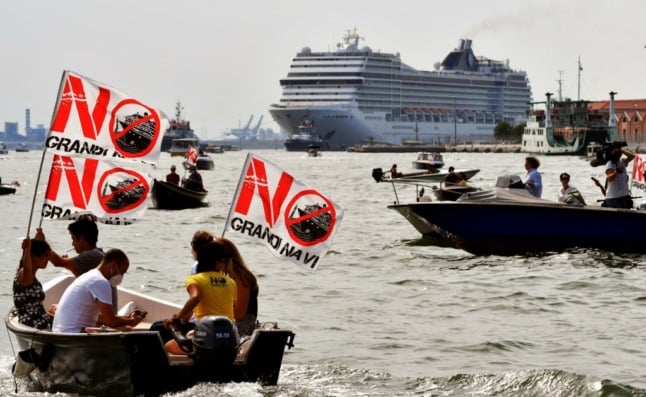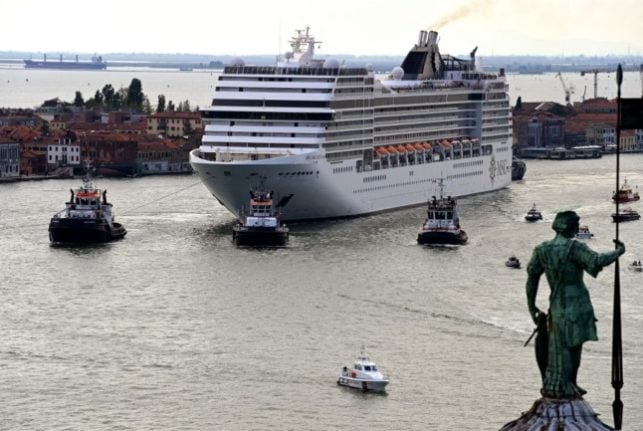Italian Prime Minister Mario Draghi announced on Tuesday that the ships would no longer be able to sail into the lagoon, after years of warnings about their impact on the local ecosystem.
The decision comes just days before a meeting of the UN’s cultural organisation Unesco, which had said it would rule on whether to add Venice to its endangered list.
READ ALSO: Is Venice really banning cruise ships this time?
“The decree adopted today represents an important step for the protection of the Venetian lagoon system,” Prime Minister Mario Draghi said after the decree was approved at a cabinet meeting.
The biggest ships will now be diverted to the city’s industrial port of Marghera.
“From August 1, large ships will no longer be able to reach Venice through the St Mark’s Basin, the St Mark’s Canal or the Giudecca Canal,” Infrastructure Minister Enrico Giovannini said.
He said the ban was a “necessary step to protect the environmental, landscape, artistic and cultural integrity of Venice”.

There would be compensation for those who lost out financially from the move, ministers said, and 157 million euros ($185 million) was being invested in the Marghera port.
However, this is viewed as only a temporary solution, with ministers calling for ideas on a new permanent terminal.
The ban will only apply to the biggest ships, with those carrying around 200 passengers viewed as “sustainable” and still allowed into the centre.
Those that fulfil any of four criteria will be banned: weighing more than 25,000 tonnes, measuring more than 180 metres long, more than 35 metres high or producing more than 0.1 percent sulphur.
The passengers aboard cruise ships provide a huge economic boost to Venice, but many residents say the giant floating hotels should not sail past the iconic St Mark’s Square.
They warn the ships cause large waves that undermine the city’s foundations and harm the fragile ecosystem of its lagoon.
The long-running debate over cruise ships was reignited by the return last month of cruises after the coronavirus pandemic, when the throngs of tourists that normally fill the streets stayed away.
READ ALSO: Hundreds demonstrate against cruise ships’ return to Venice
Venice was put on Unesco’s heritage list in 1987 as an “extraordinary architectural masterpiece”, but the body warned last month of the need for “more sustainable tourism management”.
After years of debate, Italian Culture Minister Dario Franceschini said the government had decided to act now “to avoid the real risk of the city’s inclusion on the endangered world heritage list”.
However some people in Venice said they remained sceptical on Wednesday, as the government has previously passed a series of decrees supposedly ‘banning’ cruise ships, which did not in fact result in them being removed from the lagoon.
The vice-president of tourism association Confturismo, Marco Michielli, said the new law represented a “good compromise”.
READ ALSO: ‘More local, more authentic’: How can Italy move toward responsible tourism in future?
“The Marghera solution would maintain port activity in Venice, on the one hand safeguard jobs and activities, and on the other free up the Giudecca Canal on the other,” he said.
The issue of cruise ships in Venice has sparked global debate, and last month celebrities and cultural figures including Mick Jagger, Francis Ford Coppola and Richard Armstrong, director of the New York’s Solomon R.Guggenheim Museum, issued a call for action.
In an open letter to the Italian government calling for a range of measures to better protect the city, they warned the historic site risked being “swept away” by cruise ships.



 Please whitelist us to continue reading.
Please whitelist us to continue reading.
Couldn’t come soon enough. Good job Venice!
Amen! About time.
It’s a shame it took UNESCO’s threat of an endangered heritage site, before action was taken. Better late than never.